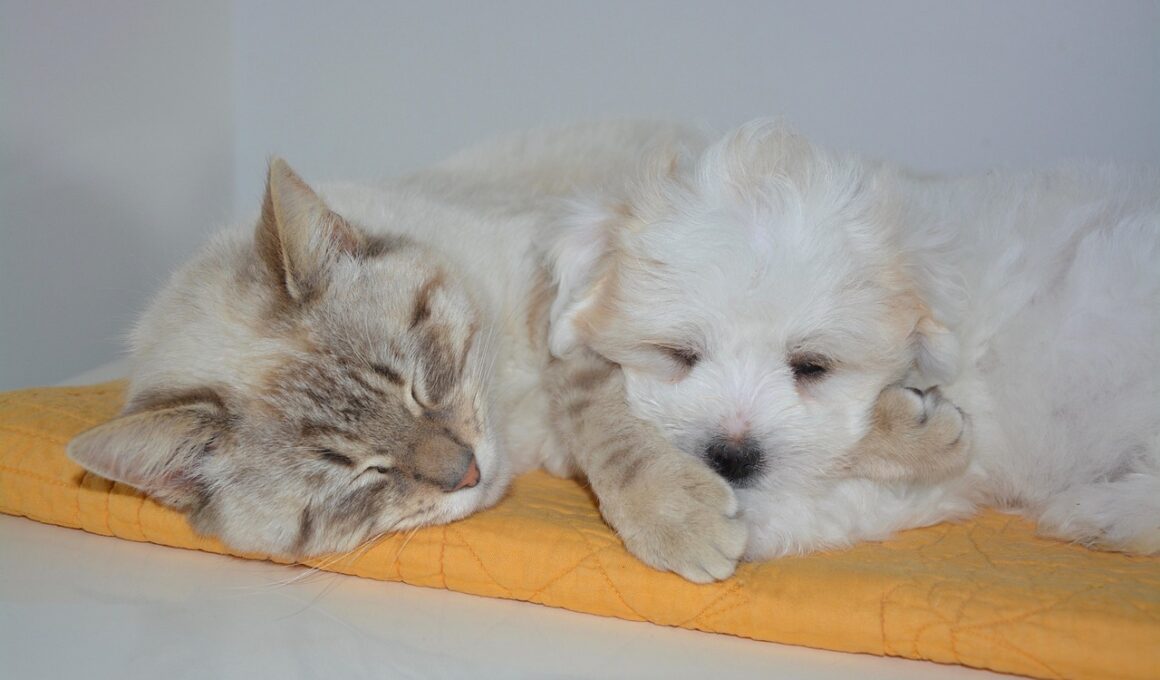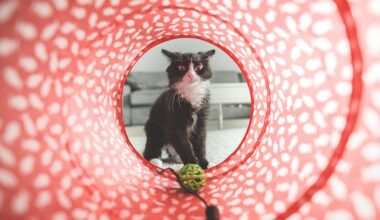Understanding Body Language During Dog and Cat Introductions
When introducing dogs and cats, understanding body language is essential for ensuring a positive interaction. Both species communicate through various body signals; recognizing these cues can alleviate stress and prevent misunderstandings. For dogs, neutral postures indicate calmness, while stiff body language or raised hackles signal discomfort or aggression. Similarly, cats may puff up their fur or flatten their ears when feeling threatened. Before the introduction, prepare a safe space with separate areas for both animals, allowing them to feel secure. This approach reduces anxiety levels significantly. When bringing them together, monitor their body language closely. Look for signs of relaxation or agitation in both pets. Positive interactions include soft eyes, relaxed tails, and playful behavior. To facilitate a smooth introduction, you might consider using leashes for dogs and providing escape routes and hiding spots for cats. Creating an environment where both pets feel comfortable to approach each other at their own pace is key. This will promote a harmonious relationship instead of a stressful confrontation. Overall, paying attention to body language helps instill trust and comfort between your pets.
In addition to recognizing stress signals, there are proactive measures you can take before the introduction. Taking the time for desensitization exercises can be beneficial. This may include allowing the dog to observe the cat from a distance where they feel safe. As comfort levels increase, reduce the distance gradually while continuing to monitor their body language. Positive reinforcement is equally important during these interactions. Reward both animals with treats and praise when they exhibit calm and friendly behavior towards each other. Creating positive associations helps them understand that being near one another leads to pleasant outcomes. Another critical aspect is to ensure that each pet has their favorite items, such as blankets or toys, in their respective spaces, making it easier for them to settle. Once both pets are relaxed with each other’s scent, you can proceed to short and supervised interactions. It’s favorable to conduct these introductions in a neutral space, avoiding either pet’s territory. This prevents territorial aggression, aiding in smoother interactions. Ultimately, take it slow and celebrate small victories for successful cohabitation. Patience truly is key when handling those early days of introduction.
Signs of Understanding and Acceptance
As you facilitate introductions between dogs and cats, watch for signs indicating acceptance. Tail wagging in dogs paired with a lowered head can signify friendliness and submission. For cats, a slow blink is a strong indicator of trust—it means they feel safe enough to show vulnerability. When observing mutual curiosity, as both animals cautiously sniff each other, it highlights their willingness to interact. Create opportunities for gentle nose touches by staying close and encouraging sniffing. Paying attention to pacing is equally crucial. If either pet becomes overstimulated or nervous, allowing breaks to cool off can help in redirecting their focus. Comfort items may assist in calming anxious cats or dogs. For instance, using calming pheromone sprays or diffusers engineered for pets is worth considering. Always redirect unwanted behaviors—such as growling or hissing—with positive reinforcement, showing that appropriate behavior gets rewarded. Over time, consistent successful interactions will build familiarity. Once comfort level exists, interactive play can be introduced gently. Engaging both pets with toys encourages bonding experiences that foster positive relationships. Providing a foundation of trust ultimately leads to a tranquil household for both species.
Another vital part of the introduction process is realizing each animal has its pace. Cats are typically more independent than dogs, so forcing interactions may create stress for the cat. Allowing them ample time to adjust is critical. It’s beneficial to keep initial meetings brief. As comfort grows, meetings can gradually extend over time. Depending on the individual personalities of your pets, you may need to constantly reevaluate how each animal feels about the introduction. In some instances, it could take weeks or even months before a cat and dog can peacefully coexist. Ensuring there are hiding spots available for the cat can further ease their anxiety, allowing them to escape if they feel threatened. Conversely, also ensuring the dog can retreat contributes to stress reduction. By observing your pet’s individual needs, you create a shared environment where trust and comfort are the focus. Be patient and do not rush the process, as it can lead to setbacks. Remember, every positive interaction lays the groundwork for future companionship. Documenting their reactions and progress is advantageous in tailoring your approach more effectively.
Learning from Each Interaction
Each introduction provides learning opportunities, creating a better understanding of your pets. Accurate observation helps you gauge which methods are most effective based on their reactions. Some dogs exhibit a playful demeanor, while others may be more cautious. Individual personalities play a crucial role in how animals adjust. In witnessing these interactions, you can identify patterns—such as a particular treat that motivates a shy dog or what type of engagement excites the cat. Consider utilizing training sessions as a bonding experience. Taking time to train dogs to respond to commands like “leave it” or “stay“ can be beneficial during these introductions. Successful commands help ensure both pets behave appropriately in each interaction. Gradually exposing them to new environments reinforces adaptability. Utilizing positive experiences helps cultivate a better relationship. Monitoring for signs of aggression allows you to step in before situations escalate. If necessary, consulting with pet behaviorists or trainers can provide additional insights tailored to your unique situation. Access to professional guidance reinforces effective communication skills between both animals. Using knowledge gained from experiences equips you with tools to manage future situations more effectively.
Furthermore, sharing the adoption journey can create a community of support, offering shared experiences with others going through similar processes. Connecting with experienced pet owners or engaging in local pet groups can yield incredible insights and advice applicable to your journey. Observing other successful introductions can also be informative and inspiring. Utilizing online resources—including training videos or expert articles—helps better prepare for the initial meet and greet. These platforms offer solutions tailored to various breeds and personality types, boosting your confidence in handling different encounters as they arise. Embrace opportunities for participation in local events where mixed breed gatherings allow socialization on neutral sites. Such gatherings enable an atmosphere conducive to gradual introductions, making learnings applicable in real-world settings. Establish relationships with other pet owners to share ideas for managing introductions harmoniously. Remember to celebrate even small achievements during the introduction process. Each step towards comfort and acceptance strengthens the bond between both animals and assures them coexist alongside one another effectively. Ultimately, the goal is creating an environment that nurtures a lasting, peaceful relationship.
Final Thoughts on Pet Introductions
In conclusion, ensuring a harmonious introduction between dogs and cats requires a thoughtful and patient approach. Understanding body language forms the cornerstone of successful introductions. Gentle observation allows you to identify cues that indicate relaxation or discomfort. By establishing a safe environment and allowing both animals to acclimate at their pace, you pave the way for building trust. Engage positively using treats and consistent praise reinforces desired behaviors. Avoid overwhelming either pet with forced interactions; take things slowly, letting them set their rhythm. Documenting progress or challenges could offer valuable insights during the process. Build a support network from fellow pet owners, trainers, or local rescue organizations that can provide guidance based on shared experiences. Maintenance of safety during early introductions will foster the foundation for lasting friendships. Always remain vigilant and responsive to their needs, as no two animals are alike. In fostering a supportive atmosphere, owners help their furry companions build connection and trust. Ultimately, successful introductions lead to enriched lives and the joy of multi-pet households. Understanding and respecting the nature of each species solidifies relationships that truly thrive.
In reflection of the pet adoption journey, it is crucial to remind yourself to stay observant and patient. Every encounter is a learning experience, providing opportunities to deepen bonds. Adapting requirements based on each pet’s unique temperament results in smoother introductions. Following the steps outlined helps to instill confidence in both animals as they navigate through this transition phase. Encourage exploration of new spaces, as it nurtures positive experiences. Remember to highlight moments of progression as reassurance. Celebrating these milestones creates a friendly atmosphere and promotes lasting relationships between your dog and your new cat. The journey may seem daunting at first, but with determination and love, success is well within reach.


